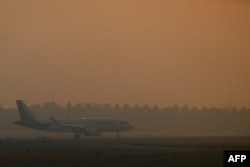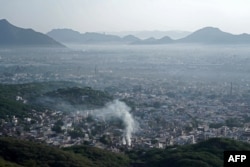India’s financial capital, Mumbai, is grappling with surging levels of air pollution, a relatively new phenomenon in a city whose location along the Arabian Sea had long protected it from the dirty air that engulfs much of North India in winter.
It is the second Indian mega city whose skies have turned grey and where buildings are shrouded in haze after the capital New Delhi that has battled air pollution in winter for years. Each of the two cities is home to about 20 million people.
This is the second year that air pollution levels have soared in Mumbai, say experts. “The pollution levels recorded earlier this month were much higher compared to the same time last year. So, the problem is becoming big,” according to Anumita Roy Chowdhury, Executive Director, Research and Advocacy, at the Center for Science and Environment. “It’s a wake-up call for the city.”
Swiss group IQAir ranked Mumbai as the world’s sixth most polluted city in mid-October. Its air, however, is still not as toxic as that in Delhi, which was ranked number three.
A construction boom that followed a lull during the COVID-19 pandemic and changing weather patterns are being blamed for Mumbai’s smog.
"Construction is currently underway at 6,000 locations in Mumbai. Climate change is adversely affecting the air quality of the Mumbai metropolitan area,” the city municipal corporation said in a statement on October 20.
In the city’s sprawling suburbs, old buildings are being pulled down to make way for tall new residential and commercial towers. Mega infrastructure projects that include a new coastal road and metro lines are under construction to ease congestion in a city whose roads are routinely choked with traffic.
As India’s economy bucks the global trend of a slowdown and posts brisk growth, the government is racing to improve the country’s inadequate infrastructure.
Mumbai city authorities have ordered builders to erect 11-meter-high barricades at construction sites and issued other guidelines to control dust. They also said anti-smog machines will be deployed to spray water to weigh down dust particles along major roads. Burning of garbage has been banned in open grounds.
But as the Air Quality Index in the city rose above 200 on several days this month – more than three times the safe limit, the pollution sparked health concerns.
“I have observed that for the last one and a half month or two months, 70% of the patients who come to the outpatient department of our hospital are suffering from cough, cold, fever, body ache or breathlessness,” said Jalil Parkar, a pulmonologist at the city’s Lilavati Hospital. He links these health issues to both the high air pollution and changing weather patterns. “The numbers suffering from upper respiratory infections used to be much lesser earlier.”
Rising air pollution can cut the life expectancy of people in South Asia, including India, by more than five years according to a study by the University of Chicago’s Energy Policy Institute published in August. It said that India is responsible for about 59% of the world’s increase in air pollution since 2013.
Experts pointed out that in India, which is now the world’s most populous nation, cities will continue to see an influx of migrants from rural areas seeking livelihoods.
“Cities will grow, they will become home to more people, and develop infrastructure, but it is important to ensure that construction, waste management and other sources that cause air pollution are controlled with very stringent action plans,” according to Chowdhury. “Those strategies are well known and in place, but the point is how strictly they are implemented,” she pointed out.
Experts have long stressed the need for massive scaling up of public transport in cities like Delhi and Mumbai to reduce the emissions from the huge number of private vehicles. Construction sites also must be brought under very strict dust control measures they say.
Mumbai authorities say they are taking proactive measures to clean up the air. But for city residents, long accustomed to strong sea breezes blowing away dust and other suspended particles, the pollution presents a new hazard.
“It started getting bad last year, but this year is really bad. When I drive past the sea bridge, I can barely see the Mumbai skyline,” says Angita Thomas, who has lived in the city for 15 years. “This is not the city I know. Mumbai was always crowded, but the air was never toxic as it is now.”






